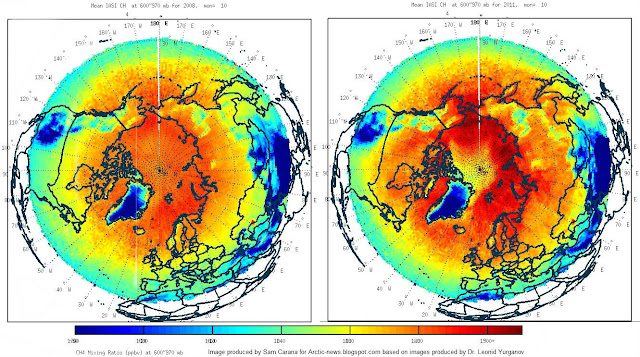Flask measurements continue to be available and the five most recent measurements show levels well over 2000 ppb.
The image below shows methane levels over a period of three years, from August 1, 2008, to August 1, 2011.
The image below shows methane levels over a period of a more recent year, from August 1, 2011, to August 1, 2012. There is a marked increase of methane at higher latitudes, compared to the earlier three years.
The image below shows methane levels in August 2012, with high levels showing up at many places.
The image below shows the most recent methane level measurements available, from September 1, 2012, to September 7, 2012. High levels of methane show up at even more places, such as in the Arctic to the north of North America.
Around this time of year, there will typically be a lot of methane at many locations on the Northern Hemisphere. The image below allows a comparison of the 2012 period with the same period last year. In early September 2011, there was not quite as much methane as there now is north of Alaska, in Greenland and along the Siberian coast. There was a lot of methane in China last year in this period in 2011, though, and the situation appears to have improved somewhat this year.
To compare things further, an image is added below showing methane levels during the same period in 2010.
Below are added images produced by Dr. Leonid Yurganov from IASA data. Note that the scales are slightly different. The images confirm the presence of high levels of methane in the Arctic Ocean north of Siberia. Further below a combination picture showing the significant rise of methane levels in that area between October 2008 and October 2011.
 |
| [click to enlarge] |
The images highlight a number of concerns:
- Methane levels are rising over the years;
- Methane levels are particularly high in the Arctic;
- Very high levels of methane are recorded in the Arctic in the months September and October, the very period when Arctic sea ice is at its lowest;
- Incidental measurements, such as at Barrow, add to concerns that levels can rise abruptly with significant amounts.
The big danger is that ferocious warming in the Arctic will trigger methane releases from hydrates and from free gas in sediments, which will further accelerate warming in the Arctic and further trigger methane releases, in a vicious circle set to spiral into runaway global warming unless action is taken to reduce the danger.









